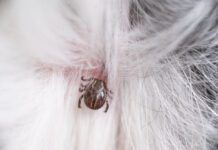Every week, I get at least one call from a reader who has had an unfortunate experience with one of the health problems we have discussed in a recent issue. Often, these readers are anguished and upset with themselves for failing to find and take a treatment path similar to the ones our article discussed because they worried that conventional care led to the demise of their dog.
I can sympathize with them. My Border Collie, Rupert, is 10, and has been afflicted with a number of small but troubling ailments throughout his life. He’s always been itchy, prone to painful ear infections, and a magnet for ticks and fleas. Until I got this job a couple years ago, I thought this was just how dogs were! I fed him Purina Dog Chow, went to the vet every so often to refill his prescriptions for Prednisone (for his itching), Panalog (for the ear infections), and whatever flea-killers seemed to be most effective. And I never made the connection between his chronic health troubles and the toxins I poured on him, in him, and around him. I could have easily killed him with all my loving care.
Since I’ve been professionally steeped in holistic dog husbandry, I’ve made some changes in Rupert’s care. I started buying a top-of-the-line kibble. I stopped having him vaccinated. I quit using Advantage every month (though I’ve used a half-dose on him once or twice a year in the past two years when we had a flea invasion). And those things, alone, have obviated the need for the Panalog and Prednisone prescriptions.
I wouldn’t go far as to say that he is “all better” as a result of these changes. He’s a lot better, though. His arthritis has not gotten any worse in the past two years, and for a dog who showed stiffness and occasional lameness fairly early in life (at about age five), that’s saying something. He’s still prone to fits of itchiness now and then, but he no longer scratches and chews himself until he’s half-naked and bloody, the way he used to. In the midst of an allergic crisis, he may chew himself pink, and lose a little hair, but not so much that most people would notice.
Last month, after Rupert had suffered an outbreak of itching – one that I ultimately traced to a recent change in the formulation of his premium kibble – I finally decided to take the leap and start feeding him a raw meat-based diet. This was made considerably easier by virtue of the fact that my freezer was full of samples of frozen raw meat diets following our article on the same. After all that ran out, I went ahead and placed an order for a month’s worth of frozen food from Old Grandad’s, a local manufacturer. I’m rounding out his new diet with Sojourner Farm’s oatmeal-type food, and as many vegetables as I can remember to toss into his dish.
His itching got a bit worse, but now I think it’s getting a bit better. Holistic health care expert CJ Puotinen has urged me in the past to publish an article about the alarming signs of problems that a dog will sometimes display for a short time when initially put on a raw foods diet . . . now I know what she was talking about! Holistic vets say it’s due to an outpouring of toxins stimulated by the arrival of the vital nutrients present in the “real” food. I think you’ll see an article about this soon!
Last year I reported that I had found a couple of odd lumps on Rupie’s side; one was diagnosed as a small fatty tumor, and one was determined to be a sebaceous cyst. Today, a frozen meat-diet maker I was speaking with on the phone happened to mention that he’s seen raw-meat diets make sebaceous cysts go away. As we spoke, I snapped my fingers for Rupe and felt his side to check on the little lump.
Damned if the cyst isn’t gone. It seems it’s never too late to improve.
-By Nancy Kerns




